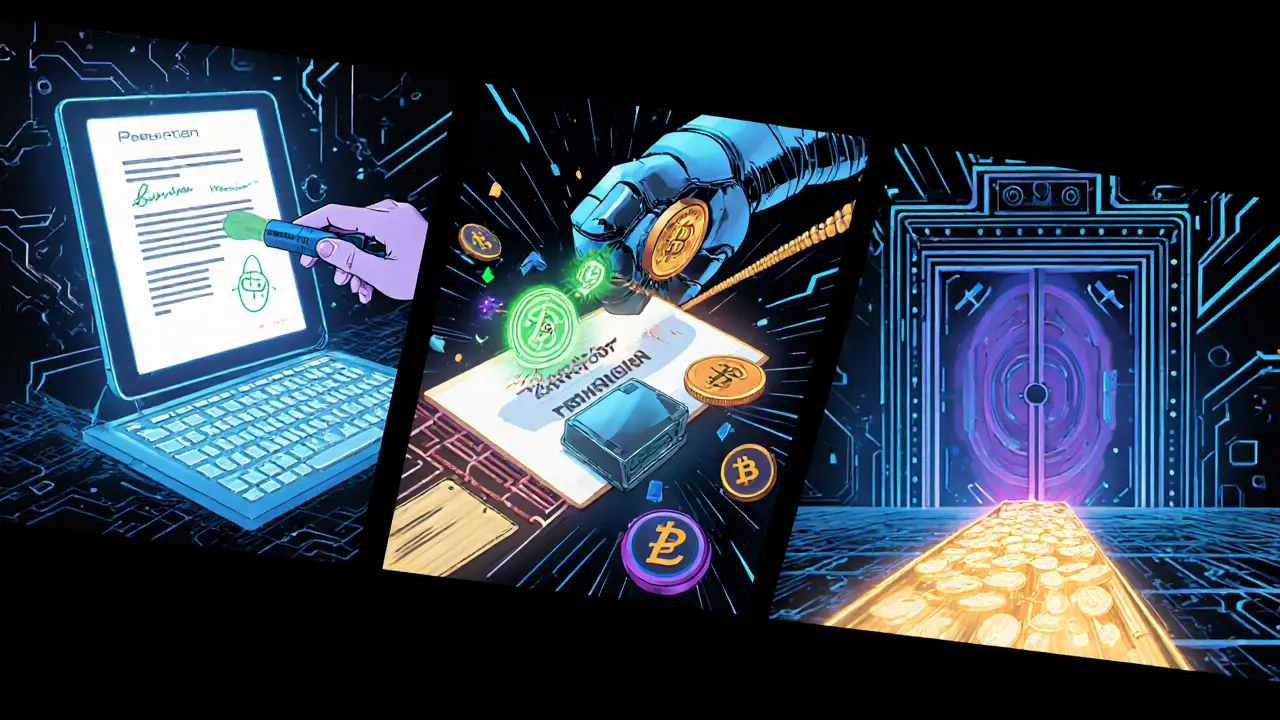- Home
- Cryptocurrency
- How Multisig Wallets Boost Cryptocurrency Security

How Multisig Wallets Boost Cryptocurrency Security
Multisig Wallet Configuration Calculator
Wallet Type: 2-of-3
Security Level: Medium
Recovery Option: Available
- Use hardware wallets for at least one key
- Store seed phrases securely in separate locations
- Define clear signing policies
- Test with small amounts before large transfers
When it comes to protecting crypto assets, multisig wallets are a type of cryptocurrency wallet that requires multiple private‑key signatures to approve a transaction. Instead of putting all trust in a single key, you spread control across several parties, creating a built‑in safety net.
Key Takeaways
- Multisig wallets replace a single point of failure with an M‑of‑N approval model.
- They dramatically lower theft risk because an attacker must compromise several keys.
- Common setups like 2‑of‑3 or 3‑of‑5 balance security with usability.
- Implementation adds complexity - proper key management and clear policies are essential.
- Businesses, DAOs, and high‑net‑worth individuals are the fastest adopters.
What Is a Multisig Wallet?
A multisignature wallet (multisig wallet) implements an "M‑of‑N" rule: out of N total private keys, at least M must sign off before funds move. For example, a 2‑of‑3 wallet needs any two of three keys, while a 3‑of‑5 wallet demands three signatures from five participants.
This model originated as a response to the vulnerabilities of traditional single‑signature wallets, where losing or exposing one key gives an attacker full access to every coin.
How Multisig Works Under the Hood
Most modern multisig solutions rely on smart contracts that encode the M‑of‑N requirement. The contract stores pending transaction data, monitors which keys have signed, and releases the funds only when the threshold is met. Because the contract itself holds the logic, none of the individual signers can bypass the rule.
Key steps in a typical flow:
- A transaction proposal is submitted to the contract.
- The contract marks it as pending and records the proposer’s address.
- Each designated signer reviews the details and adds their cryptographic signature.
- When the required number of signatures is collected, the contract executes the transfer.
During this process, the contract also logs who signed and when, providing an immutable audit trail.
Security Benefits in Detail
Because the system demands multiple independent keys, it mitigates several attack vectors:
- Physical theft or loss: If you lose one hardware device, the remaining keys keep the funds safe.
- Phishing attacks: Even if a hacker tricks a signer into revealing a key, they still need the other signatures.
- Insider threats: No single employee can move the money alone, which is crucial for companies.
- Software compromise: A malware‑infected machine can only submit one signature, not enough to pass the threshold.
Research from security firms such as BitPay shows that multisig adoption can cut the probability of successful theft by more than 70% compared to single‑sig setups, especially for large stakes.
Popular Configurations and Their Trade‑offs
The right M‑of‑N ratio depends on how you balance security, convenience, and governance:
| Feature | Single‑Signature | Multisig (e.g., 2‑of‑3) |
|---|---|---|
| Required signatures | 1 | 2 of 3 |
| Risk of total loss if one key is compromised | High | Low |
| Recovery options | Depends on backup of one key | Can use the third key for recovery |
| Ideal for | Small personal holdings | Businesses, DAOs, high‑value individuals |
| Operational complexity | Low | Medium‑High |
A 2‑of‑3 layout is popular among freelancers who keep one key on a phone, one on a hardware device, and a backup on paper. A 3‑of‑5 arrangement suits enterprises that need a board‑level approval process.

Implementation Checklist
Setting up a robust multisig wallet involves several moving parts. Below is a practical list that covers everything you need before you start signing transactions.
- Hardware Wallets: Devices like Ledger or Trezor store private keys offline. Hardware wallet usage is strongly recommended for at least one signer.
- Software that supports M‑of‑N: Platforms such as Trust Wallet, Lace Shared Wallet, or Electrum allow you to define the threshold.
- Secure seed‑phrase storage: Write down each seed phrase on fire‑proof paper and store it in separate locations.
- Clear signing policy: Decide who can propose, who can sign, and under what circumstances the third key can act as a recovery.
- Network safety: Use a trusted VPN or a dedicated air‑gapped machine for signing operations.
- Testing phase: Perform a small test transfer to confirm the workflow before moving large sums.
Real‑World Use Cases
Businesses often need shared control over treasury funds. A crypto‑centric startup might allocate 30% of its reserve to a 2‑of‑3 wallet, with the CEO, CFO, and a legal officer as signers. This prevents a single rogue employee from draining the account.
Decentralized Autonomous Organizations (DAOs) rely heavily on multisig for governance. The DAO treasury is locked behind a 3‑of‑5 contract, ensuring that any proposal must gather support from a majority of elected representatives.
Protocol developers use multisig to protect the upgrade keys of smart contracts. By requiring multiple core contributors to approve a change, the community reduces the risk of a malicious upgrade.
Some escrow services employ a “buyer‑seller‑arbiter” 2‑of‑3 model: the buyer and seller each hold a key, while a neutral third party can step in if a dispute arises.
Future Outlook
As the crypto ecosystem matures, multisig is moving from a niche security tool to a baseline requirement for any sizable holding. Recent advances include:
- Improved UI/UX in wallets like Trust Wallet, which now bundle a real‑time Security Scanner that flags risky addresses before a signature is added.
- Layer‑2 solutions supporting multisig without sacrificing speed, making it viable for high‑frequency trading.
- Standardized BIP‑322 message signing, allowing multisig verification across different blockchains.
Regulators are also taking note. In several jurisdictions, having a multisig policy is viewed as a best practice for custodial services, which could become a compliance requirement for crypto exchanges.
Quick Recap
If you want a single phrase that captures the core benefit, it’s multisig wallets. They turn a single point of failure into a collaborative safety net.
Next Steps & Troubleshooting
After you’ve set up your wallet, keep these tips handy:
- Missing signature? Double‑check that each signer used the correct network (mainnet vs testnet) and that their hardware device was unlocked.
- Transaction stuck in pending? Verify the smart contract’s nonce and ensure the gas limit is sufficient for the network’s current load.
- Key lost? Use the recovery key (the third signer) to reconstruct the wallet, then rotate all keys immediately.
- Unexpected address in the UI? Run the built‑in security scanner; it will alert you to known phishing domains.
When in doubt, run a dry‑run with a tiny amount of crypto. That small test will reveal configuration gaps without exposing a large balance.
Frequently Asked Questions
What does M‑of‑N actually mean?
M‑of‑N defines the minimum number (M) of signatures needed out of a total pool (N) of private keys before a transaction can be executed. For example, 2‑of‑3 means any two of the three keys can approve.
Can I use a multisig wallet for Bitcoin and Ethereum at the same time?
Yes, many wallets support cross‑chain multisig. You create a separate smart‑contract or script for each blockchain, but the same set of keys can control both.
Is a multisig wallet still safe if one of my hardware devices is compromised?
Compromise of a single device does not give an attacker enough signatures to move funds, assuming your M‑of‑N threshold is higher than one. The attacker would still need the remaining keys.
How do I recover funds if I lose two keys in a 3‑of‑5 wallet?
You can’t recover the wallet without the required number of keys. That’s why a robust backup strategy-storing seed phrases in separate secure locations-is essential.
Do multisig wallets increase transaction fees?
The fee is usually slightly higher because the transaction includes additional data (signatures). However, the increase is marginal-typically a few cents on major networks.
Cormac Riverton
I'm a blockchain analyst and private investor specializing in cryptocurrencies and equity markets. I research tokenomics, on-chain data, and market microstructure, and advise startups on exchange listings. I also write practical explainers and strategy notes for retail traders and fund teams. My work blends quantitative analysis with clear storytelling to make complex systems understandable.
Popular Articles
21 Comments
Write a comment Cancel reply
About
DEX Maniac is your hub for blockchain knowledge, cryptocurrencies, and global markets. Explore guides on crypto coins, DeFi, and decentralized exchanges with clear, actionable insights. Compare crypto exchanges, track airdrop opportunities, and follow timely market analysis across crypto and stocks. Stay informed with curated news, tools, and insights for smarter decisions.





In the labyrinthine corridors of cryptographic finance, multisignature schemes are often lauded as the panacea for all custodial anxieties. Yet one must question the underlying assumptions that grant such reverence to a mere aggregation of public keys. The provenance of the firmware governing hardware wallets, for instance, remains shrouded in a veil of corporate secrecy that could conceal malicious backdoors. Moreover, the very act of distributing keys across multiple parties introduces an expanded surface for social engineering attacks, wherein an adversary may coerce a single holder into compliance. The statistical probability of collusion among keyholders, while ostensibly low, cannot be dismissed in geopolitical contexts where nation‑state actors possess ample resources. It is also incumbent upon the practitioner to consider the entropy of seed generation; a compromised RNG in any device nullifies the theoretical security benefits of multisig. In a scenario where the recovery mechanism is exploited, the purported “safety net” transforms into a single point of failure. The deterministic nature of blockchain consensus further exacerbates the risk, as any delay or dispute among signatories could precipitate a cascade of transaction stalls, undermining market confidence. While the architecture of N‑of‑M signatures appears robust, the implementation layers often betray a chasm between design and reality. Consequently, it is prudent to adopt a holistic security posture that extends beyond the mere configuration of keys. One must audit firmware, enforce strict operational procedures, and maintain vigilant monitoring of signing activities. Only through such comprehensive diligence can the theoretical advantages of multisignature wallets be realized without succumbing to hidden vulnerabilities.
Wow, thanks for the exhaustive dissertation – I guess we’ll all need a PhD in cryptography just to set up a wallet now.
Good thing the community thrives on sarcasm, otherwise we’d be drowning in paperwork.
Multisig definitely feels like a safety net for my crypto peace of mind.
Honestly, the overhead of M‑of‑N with hardware integration just adds latency without appreciable entropy gain.
Looks fancy, but I’d rather not deal with three keys for a coffee purchase.
For anyone starting out, I recommend using a hardware wallet for at least one of the keys and storing the seed phrases in geographically separate, fire‑proof boxes.
This approach mitigates both digital and physical risks.
Also, establish a clear signing policy within your team to avoid ambiguities.
Do you really trust a consortium of strangers, or are you just hoping the “distributed trust” model will magically keep the shadows at bay?
There’s a reason the elite keep their holdings in cold storage, not in a collaborative signing room.
Indeed, the confluence of multiple signatures is merely a façade, masking the inevitable centralization of power in the hands of those who control the recovery process.
Multisig is just code. It won’t protect you from dumb mistakes.
People love to romanticize “shared custody,” yet they ignore the fact that a single compromised key can jeopardize the entire vault. Think before you glorify collaboration.
While the technical merits of multisignature arrangements are well‑documented, practitioners must also attend to the cultural aspects of trust and responsibility within their teams.
Transparent communication, regular audits, and contingency drills are essential to operational resilience.
Ah, the drama of cryptographic guardianship! 🌟 One might imagine a legion of digital knights, each brandishing a private key like Excalibur, yet the true saga lies in the mundane act of pressing “Approve.”
Alas, the narrative collapses when a single keystroke betrays the covenant!
Do we then lament the loss of mythic grandeur, or embrace the sober reality of protocol?
Hey folks, just a reminder: always test your multisig setup with tiny amounts before moving large sums. It saves a lot of headaches later.
From a systems perspective, integrating N‑of‑M signatures introduces additional RPC latency, which can impact high‑frequency trading bots.
Ensure your node infrastructure can tolerate the extra communication overhead.
One cannot simply dismiss the philosophical implications of dispersing authority across multiple custodians; the very act of delegating trust invites a reshaping of our concept of ownership.
When we entrust a subset of keys to disparate entities, we are, in essence, redefining the locus of sovereignty from the individual to a collective, thereby challenging the classical notion of singular control.
This diffusion, while ostensibly protective, may also erode personal accountability, fostering a diffusion of responsibility that can be weaponized by malicious actors who exploit the ambiguity inherent in shared consent mechanisms.
Thus, the discourse must evolve beyond mere technical specifications to embrace a broader ethical framework that scrutinizes the societal ramifications of such cryptographic constructs.
Friendly tip: When configuring your 2‑of‑3 wallet, double‑check that each device’s firmware is up‑to‑date.
Older versions may have known vulnerabilities that could be exploited.
Also, keep a written record of the public keys in a secure location-just in case you need to recover.
Multisig is the haute couture of crypto security.
Make sure each key is stored in a different physical location.
From an epistemological standpoint, the efficacy of multisignature wallets hinges upon both the robustness of cryptographic primitives and the rigor of operational discipline.
It is insufficient to rely solely on algorithmic strength without embedding thorough procedural safeguards.
Consequently, a holistic approach that marries technical excellence with disciplined governance will yield the most resilient custodial architecture.
Isn’t it delightful how the community hails multisig as the ultimate safeguard, yet conveniently forgets that the human element remains the weakest link?
We pat ourselves on the back for requiring two signatures, while overlooking the fact that a single compromised actor can still wreak havoc.
Meanwhile, the glossy marketing material glosses over the inevitable friction and delay introduced by coordinating multiple parties.
Sure, it’s “secure,” if you enjoy waiting hours for a transaction to be approved while your assets sit idle.
In the grand theater of crypto, multisig is just another prop, and the real drama unfolds when someone’s private key gets leaked.
So, before you crow about the protections, ask yourself whether you’d rather have a single robust key or a trio of semi‑secure keys tangled in bureaucracy.
While the formalism of N‑of‑M signatures suggests an elegant solution, one must remain vigilant to the sociotechnical dynamics that underlie any shared custody arrangement. 😊